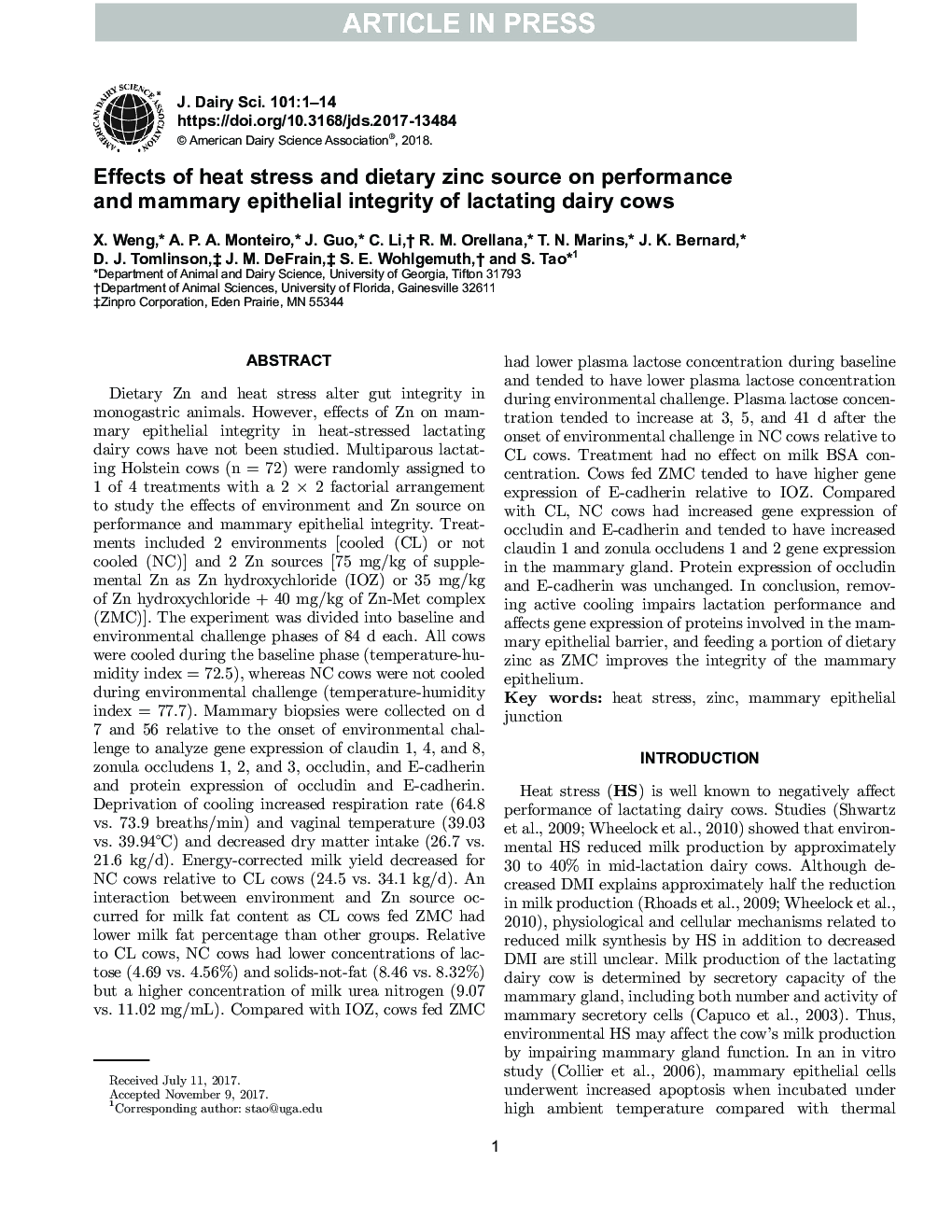| کد مقاله | کد نشریه | سال انتشار | مقاله انگلیسی | نسخه تمام متن |
|---|---|---|---|---|
| 8501485 | 1553842 | 2018 | 14 صفحه PDF | دانلود رایگان |
عنوان انگلیسی مقاله ISI
Effects of heat stress and dietary zinc source on performance and mammary epithelial integrity of lactating dairy cows
ترجمه فارسی عنوان
اثرات استرس گرما و منبع رژیم غذایی بر عملکرد و یکپارچگی اپیتلیال پستان گاو های شیرده
دانلود مقاله + سفارش ترجمه
دانلود مقاله ISI انگلیسی
رایگان برای ایرانیان
کلمات کلیدی
استرس گرما، فلز روی، اتصال اپیتلیال پستان،
موضوعات مرتبط
علوم زیستی و بیوفناوری
علوم کشاورزی و بیولوژیک
علوم دامی و جانورشناسی
چکیده انگلیسی
Dietary Zn and heat stress alter gut integrity in monogastric animals. However, effects of Zn on mammary epithelial integrity in heat-stressed lactating dairy cows have not been studied. Multiparous lactating Holstein cows (n = 72) were randomly assigned to 1 of 4 treatments with a 2 à 2 factorial arrangement to study the effects of environment and Zn source on performance and mammary epithelial integrity. Treatments included 2 environments [cooled (CL) or not cooled (NC)] and 2 Zn sources [75 mg/kg of supplemental Zn as Zn hydroxychloride (IOZ) or 35 mg/kg of Zn hydroxychloride + 40 mg/kg of Zn-Met complex (ZMC)]. The experiment was divided into baseline and environmental challenge phases of 84 d each. All cows were cooled during the baseline phase (temperature-humidity index = 72.5), whereas NC cows were not cooled during environmental challenge (temperature-humidity index = 77.7). Mammary biopsies were collected on d 7 and 56 relative to the onset of environmental challenge to analyze gene expression of claudin 1, 4, and 8, zonula occludens 1, 2, and 3, occludin, and E-cadherin and protein expression of occludin and E-cadherin. Deprivation of cooling increased respiration rate (64.8 vs. 73.9 breaths/min) and vaginal temperature (39.03 vs. 39.94°C) and decreased dry matter intake (26.7 vs. 21.6 kg/d). Energy-corrected milk yield decreased for NC cows relative to CL cows (24.5 vs. 34.1 kg/d). An interaction between environment and Zn source occurred for milk fat content as CL cows fed ZMC had lower milk fat percentage than other groups. Relative to CL cows, NC cows had lower concentrations of lactose (4.69 vs. 4.56%) and solids-not-fat (8.46 vs. 8.32%) but a higher concentration of milk urea nitrogen (9.07 vs. 11.02 mg/mL). Compared with IOZ, cows fed ZMC had lower plasma lactose concentration during baseline and tended to have lower plasma lactose concentration during environmental challenge. Plasma lactose concentration tended to increase at 3, 5, and 41 d after the onset of environmental challenge in NC cows relative to CL cows. Treatment had no effect on milk BSA concentration. Cows fed ZMC tended to have higher gene expression of E-cadherin relative to IOZ. Compared with CL, NC cows had increased gene expression of occludin and E-cadherin and tended to have increased claudin 1 and zonula occludens 1 and 2 gene expression in the mammary gland. Protein expression of occludin and E-cadherin was unchanged. In conclusion, removing active cooling impairs lactation performance and affects gene expression of proteins involved in the mammary epithelial barrier, and feeding a portion of dietary zinc as ZMC improves the integrity of the mammary epithelium.
ناشر
Database: Elsevier - ScienceDirect (ساینس دایرکت)
Journal: Journal of Dairy Science - Volume 101, Issue 3, March 2018, Pages 2617-2630
Journal: Journal of Dairy Science - Volume 101, Issue 3, March 2018, Pages 2617-2630
نویسندگان
X. Weng, A.P.A. Monteiro, J. Guo, C. Li, R.M. Orellana, T.N. Marins, J.K. Bernard, D.J. Tomlinson, J.M. DeFrain, S.E. Wohlgemuth, S. Tao,
